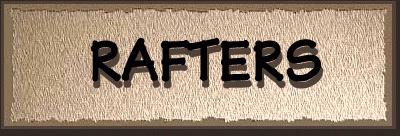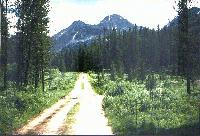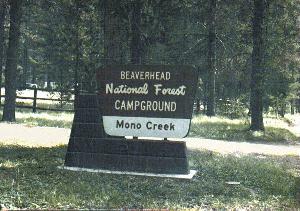





The rafters at the cabin do a lot more than hold up the roof: our cabin history was written on one of them above the kitchen counter; I was often reprimanded for hanging from them by my knees; fishing poles were laid across them; and homemade plywood hooks attached to them hold the windows open and support the Coleman lanterns essential to all our late day activities. A memory I treasure most is the time of evening when the fireplace gives off light which flicks on the beautiful wood of the pine rafters...a deep yellow-orange glow making them come alive with warmth and beauty. The V-shaped roof supports lead to the gigantic trophy stuffed elk head on the wall ajacent the porch: the top of the narrow stairway at the other end allows you to walk right out onto the rafters. The stories of the "early days" of the cabin were always fresh in my mind ... how there were so many people at the cabin on holidays they had to sleep on beds made with boards laid across the rafters. Come take a look now at some additional cabin country nostalgia... between the rafters.




Above the cabin on the main road we frequently hiked up to the meadows, a great place for taking a swim in the sun-warmed water; inner tubes were terrific toys for meandering throughout this beautiful open land fringed with pines on all sides. When I was very young, an abandoned boxcar dotted the landscape at the entrance to the meadows... it is now in a Illinois Railway Museum in Chicago, most likely with my fingerprints and initials carved within. One of the highlights of this area is watching Saddle Back Mountain loom up before you. I have many have fond memories of that view from the time-trodden, often washed out roadway.


Mono Creek Campground was a hub of activity in the early days when the cabin was being built. Though I wasn't born yet I was able to capture the excitement of seeing my grandparents, aunts, uncles, cousins and neighbors as the cabin project progressed on 8mm movies. They set up their frequent temporary headquarters at the campground and made the trek across the road and up the path to the cabin site with tools in hand. The many stories I was told about those days made them seem magical and often cross my mind when I see the campground.


Still further up the road is what remains of the once productive town of Coolidge, only recently having been claimed a treasure to the State of Montana. Seeing it deteriorate year after year as I was growing up was very sad. The building we referred to as the mill was always full of adventure and intrigue for me.. whether explored under the squelching concern of parents or more daring friends; we used to climb the long steep stairway inside the gigantic structure. The railroad tracks were at the top where ore cars once dumped their great loads into the building which covered much of the mountainside. There were many fascinating things at the mill: massive disks of poured concrete with concave tops, huge metal gears and paddles -- still intact as though time had stood still since they had swirled the water around and around on those slabs to sink the heavier elements away from the rocks and dirt. Often we heard eerie clatterings and creaking noises of the stressed beams and imaginations ran wild with what ghosts of the past the building might still harbor. At other times it was hauntingly still allowing us to reflect on who had worked there and what life must have been like for them. A rusty tinged mud puddle was outside the mill at the bottom of the mountain.. edged in sea green and tourquoise... remnants of all the processes that had taken place in the building on the hill.


The Coolidge Ghost Town consisted of a narrow roadway buried in years of nonuse, with primitive houses overgrown with weeds on either side. The homes have weathered to silver-grey with deep ruts in the wood, and wonderful shades of rust and black under the eaves. A few shacks were more secluded at ends of this main dragstrip. There were signs of livelihood all around: an abandoned coffee pot or utensil here and there, cots, bedsprings, old boots, or shirts, tobacco cans, and kitchen furniture often left behind. The covered bridge which sheltered the stream crossing had picnic tables and benches intact though the bridgehouse itself was caved in right over the river with water still rushing inside and around it; it was obvious that there was time for play as well as work in Coolidge. The city must have been an awesome site in its day, so remote with the pines forest so close in and the stream running nearby. It's hard to imagine a more beaufiful or peaceful setting with chipmunks scampering about and birds jostling around on tree limbs. Scouting around the Ghost Town was great fun as a child... and even later as an adult when the mind was more appreciative of the history of the place, and what untold stories were hovering in its midst. We never did see a ghost, but there were times we were sure we heard them!

The photos on this page are from Jerry's
collection taken during our Montana vacation of 1995.
collection taken during our Montana vacation of 1995.
